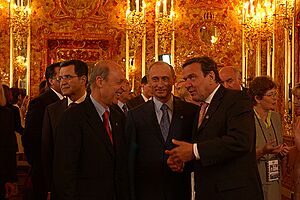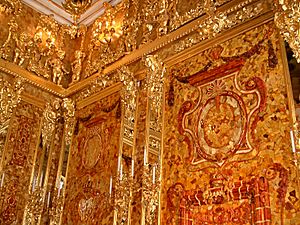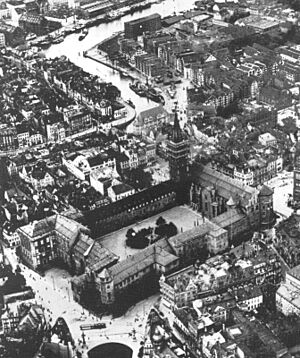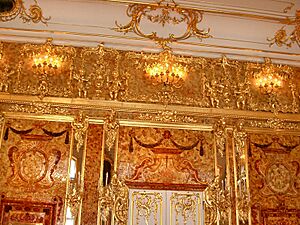Amber Room facts for kids
The Amber Room was a very special room decorated with shiny amber panels, gold, and mirrors. It was located in the Catherine Palace near Saint Petersburg, Russia.
This amazing room was built in the 1700s in Prussia (which is now part of Germany). It was later taken apart and disappeared during World War II. Before it was lost, many people called it the "Eighth Wonder of the World" because it was so beautiful and unique. Years later, a new Amber Room was carefully rebuilt. Work started in 1979 and the new room was finished and opened in the Catherine Palace in 2003.
The Amber Room was first planned in 1701 for the Charlottenburg Palace in Berlin. But it ended up being installed in the Berlin City Palace. It was designed by a German artist named Andreas Schlüter and a Danish amber expert named Gottfried Wolfram. They worked on it until 1707, and then other amber masters continued the work.
It stayed in Berlin until 1716. Then, the Prussian King Frederick William I gave it as a gift to his friend, Tsar Peter the Great of the Russian Empire. In Russia, the room was set up in the Catherine Palace. After being made bigger and updated several times, it covered more than 55 square meters (about 592 square feet) and contained over 6 tons (about 13,228 pounds) of amber!
During World War II, the Amber Room was taken by Nazi Germany's Army Group North. It was moved to Königsberg (now Kaliningrad) to be rebuilt and shown there. In early 1944, as Allied forces got closer to Germany, the room was taken apart and packed into crates to be stored in the castle basement. Königsberg was heavily bombed in August 1944, and after that, no one knew for sure where the room went. Its final fate and where it is now, if it still exists, remain a big mystery. In 1979, people decided to create a new Amber Room at the Catherine Palace in Pushkin. After many years of hard work by Russian artists and with help from Germany, it was completed and opened in 2003.
Contents
What Made the Amber Room Special?
The Amber Room was an incredibly valuable work of art. It had amazing features like shiny gold decorations, detailed carvings, 450 kilograms (about 990 pounds) of amber panels, gold leaf, sparkling gemstones, and mirrors. All of these looked even more beautiful when lit by candles. It also had statues of angels and children.
Because it was so unique and beautiful, the first Amber Room was sometimes called the "Eighth Wonder of the World". Today, experts think the original room would be worth hundreds of millions of dollars.
The Amber Room's Journey Through History
How the Amber Room Was Created
The Amber Room began in 1701. It was meant for the Charlottenburg Palace, which was the home of Frederick, the first King of Prussia. His wife, Sophia Charlotte, really wanted it. The idea and design for the room came from Andreas Schlüter. It was built by Gottfried Wolfram, a skilled craftsman from the Danish court, with help from amber experts Ernst Schacht and Gottfried Turau.
Even though it was first planned for Charlottenburg Palace, the finished amber panels were eventually put in the Berlin City Palace. But the Amber Room didn't stay there for long. Peter the Great of Russia admired it when he visited. In 1716, King Frederick I's son, Frederick William I, gave the room to Peter as a gift. This helped create a strong friendship between Russia and Prussia against Sweden.
The original design of the Amber Room was changed and improved in Russia by both German and Russian craftsmen. It was Peter's daughter, Empress Elizabeth, who decided the amber treasure should be placed in the Catherine Palace. This was where the Russian Imperial family usually spent their summers. After several updates in the 1700s, the room grew to cover more than 55 square meters (about 592 square feet) and contained over 6 tons (about 13,228 pounds) of amber. It took more than ten years to build the room.
When the Amber Room Was Taken During World War II
Soon after the German invasion of the Soviet Union began in World War II, the people in charge of protecting art in Leningrad tried to take the Amber Room apart and move it to safety. However, over the years, the amber had become very dry and fragile. It was impossible to move the room without the amber breaking into pieces. So, they tried to hide the Amber Room behind ordinary wallpaper, hoping the German forces wouldn't find it. But this attempt to hide such a famous artwork didn't work.
German soldiers from Army Group North took the Amber Room apart in just 36 hours, with two experts watching. On October 14, 1941, the valuable room arrived in Königsberg in East Prussia. It was stored and displayed in the town's castle. On November 13, 1941, a Königsberg newspaper announced that the Amber Room was on exhibition at Königsberg Castle.
The Last Known Days in Königsberg
Orders from Hitler in January 1945 told people to move stolen items out of Königsberg. This allowed Albert Speer, who was in charge of weapons, to transport important cultural goods. However, before the Amber Room could be moved, Erich Koch, who was in charge of Königsberg during the last months of the war, left his post and ran away from the city. He left General Otto Lasch in charge.
In August 1944, Königsberg was heavily bombed by the Royal Air Force. It was also badly damaged by the cannons of the advancing Red Army before the city was finally taken on April 9, 1945.
The Mystery of the Amber Room's Disappearance
After the war, the Amber Room was never seen in public again. However, there have been occasional stories that parts of it survived. Some people who saw it claimed the famous room was loaded onto the ship Wilhelm Gustloff. This ship left Gdynia on January 30, 1945, and was then quickly sunk by a Soviet submarine.

In 1997, an Italian stone mosaic called "Feel and Touch" was found in Germany. This mosaic was one of four stones that had decorated the Amber Room. It was found with the family of a soldier who said he helped pack up the amber chamber. The mosaic was given to the Russian authorities and was used in the reconstruction of the room.
In 1998, two different groups, one German and one Lithuanian, announced they had found the Amber Room. The German team thought it was in a silver mine, while the Lithuanian team believed it was buried in a lagoon. But neither of these places turned out to hold the Amber Room.
In 2004, a long investigation by British journalists Catherine Scott-Clark and Adrian Levy concluded that the Amber Room was most likely destroyed. This happened when Königsberg Castle was damaged, first by the Royal Air Force bombing in 1944, and then by the Soviets burning the castle and shelling its remaining walls. Official reports from the Russian National Archives, written by Alexander Brusov (who led the Soviet team looking for the Amber Room after the war), agreed with this idea. The official report stated: "Looking at all the facts, we can say that the Amber Room was destroyed between April 9 and 11, 1945."
These dates match the end of the Battle of Königsberg, which finished on April 9 with the German soldiers giving up. A few years later, Brusov publicly said something different. People believe he did this because of pressure from Soviet officials, who didn't want to be blamed for the loss of the Amber Room.
Other information found in the archives showed that the remaining Italian stone mosaics were found in the burned remains of the castle. Scott-Clark and Levy believed that the Soviets kept searching for the Amber Room, even though their own experts thought it was destroyed, because they wanted to know if any of their own soldiers were responsible for its destruction. Scott-Clark and Levy also thought that others in the Soviet government found the story of the Amber Room's theft useful for Cold War propaganda. Russian government officials have since said these conclusions are not true. Adelaida Yolkina, a senior researcher at the Pavlovsk Palace, reportedly said: "It's impossible to imagine the Red Army being so careless that they let the Amber Room be destroyed."
After the report was made public, Leonid Arinshtein, who was a lieutenant in the Red Army during the Battle of Königsberg, said: "I probably was one of the last people who saw the Amber Room." He explained that the whole city was burning because of artillery attacks. But he also denied claims that the Red Army burned the city on purpose, saying: "What soldiers would burn the city where they will have to stay?"
Another idea, held by some people living in Kaliningrad (which used to be Königsberg) today, is that at least parts of the room were found in the Königsberg Castle cellars after World War II by the Red Army. They believe the Amber Room was still in good condition. This was supposedly not admitted at the time so that the Nazis could be blamed. To keep this story quiet, access to the castle ruins, which was allowed after World War II, was suddenly stopped for everyone, including historians and archaeologists. But some say the room is in a storage place near Königsberg Castle.
Then in 1968, even though experts around the world protested, Soviet leader Leonid Brezhnev ordered the destruction of Königsberg Castle. This made it almost impossible to search the last known place where the Amber Room was seen. Later, the search for the Amber Room continued in different places, including near Wuppertal, Germany.
Another idea suggests it might be in a bunker in Mamerki in northeastern Poland. Or perhaps Stalin ordered the Amber Room to be replaced with a copy before it was stolen, hiding the original. The main problem with finding the Amber Room is that the Nazi government hid many items in hard-to-reach places, often without keeping records. This leaves a very large area to search. The Germans also moved items to places far from Europe in some cases. The search for the Amber Room has also been stopped by authorities in some cases, for example, at Frýdlant castle, because of the castle's historical importance.
In October 2020, Polish divers from the Baltictech group found the wreck of the SS Karlsruhe. This ship was part of Operation Hannibal, a sea evacuation that helped over a million German soldiers and civilians escape from East Prussia as Soviet forces advanced. The ship was attacked off the coast of Poland by Soviet aircraft after it sailed from Königsberg in 1945. The wreck holds many crates with unknown contents. An online news website, Live Science, reported that this German steamship might hold crates containing parts of the Amber Room. However, divers later found that the crates on the ship contained military equipment and personal belongings.
Rebuilding the Amber Room

In 1979, the Soviet government decided to build a copy of the Amber Room at Tsarskoye Selo. This project took 24 years and involved 40 Russian and German experts in amber craftsmanship. Using original drawings and old black-and-white photographs, they tried their best to make the new Amber Room exactly like the original. This included matching the 350 different shades of amber in the original panels and decorations. A big challenge was finding enough skilled workers, because amber carving was an art form that had almost been forgotten.
The project faced money problems at the start, but these were solved with a donation of US$3.5 million from the German company E.ON. By 2003, the Russian craftsmen had mostly finished their work. The new room was officially opened by Russian President Vladimir Putin and German Chancellor Gerhard Schröder during the 300th anniversary celebration of the city of Saint Petersburg. In Kleinmachnow, near Berlin, there is a miniature Amber Room that was made to look like the original. A collector from Berlin named Ulla Klingbeil had this copy made from real East Prussian amber.
Images for kids
-
Amber case presented by Friedrich Wilhelm I to Peter the Great during his stay in Berlin in 1716.
See also
- Art in Nazi Germany
- Nazi gold train
- Siege of Leningrad
- Štěchovice treasure








